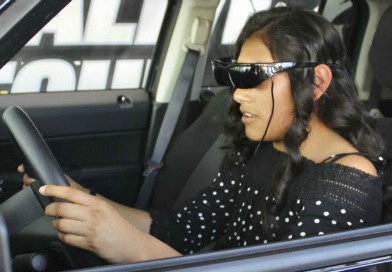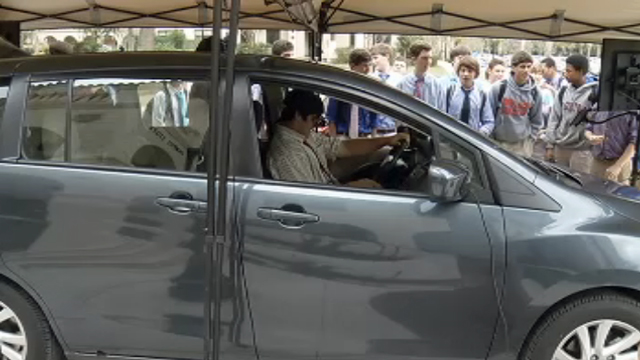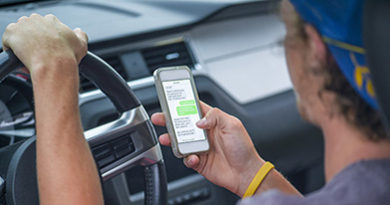Pioneer Valley Students Encouraged To ‘Arrive Alive’
Krista Chandler kchandler@leecentralcoastnews.com
Pioneer Valley High School students received a lesson in arriving alive Friday morning. The Arrive Alive tour team visited the high school with a vehicle simulator to show students how difficult it is to drive when distracted.
The program, which targets sophomores who are beginning to learn to drive, as well as seniors who might engage in senior activities usually accompanied by drinking, had students lined up around the Jeep simulator to test their skills.
The majority crashed the simulator vehicle, which had the option of showing a drunken- or distracted-driving simulation. It left the students with a new perspective about the dangers of driving while texting or under the influence.
“I wouldn’t do it,” said sophomore Miriam Cruz, after she simulated a drunken-driving experience.
Cruz said that while she doesn’t currently drive, simulators like this will help deter her and her peers from driving while texting or under the influence.
“It was blurry,” Cruz said. “You don’t see where you’re going.”
Following the simulation, students received “distracted-driving citations” that detailed exactly what went wrong during their simulation, including infractions for swerving, driving on the wrong side or off of the road, collision and even vehicular manslaughter.
On the back of the “citation” were statistics provided by the Arrive Alive tour that spelled out how big of an issue distracted driving is among teenagers.
Statistics included that 25 percent of teens respond to text messages every time they drive; engaging in manual-visual subtasks increases the risk of collision by three times, but texting increases the crash risk by 23 times; and that using a cellphone while driving will delay a driver’s reactions as much as having a 0.08 blood alcohol content.
The Arrive Alive tour was created after Patrick DeGrasse, CEO of the company, had negative experiences within his family because of drunken driving.
The Michigan-based tour, which started over 10 years ago, travels across the country year-round to visit students in an effort to stop distracted and drunken driving ahead of time.
“(DeGrasse) wanted to help other families not have the same problems,” said Ayron Austin, a team leader at Arrive Alive who was also leading the simulation Friday. “The tour is his legacy.”
Austin added, “Sometimes, some students find it more as a video game or something silly. But, we hope we can reach at least one kid. If we can save one life, it’s worth it, and we hope they encourage everyone around them not to drink or text and drive.”
“It’s a hands-on activity, and it helps it sink in better for them,” he added.
Savannah Smith, a junior at Pioneer Valley, spent the rest of the time allotted for Arrive Alive watching an “Every 15 Minute” video from San Marcos High School in Santa Barbara, which was provided to watch afterward to further drive home the point.
“It can happen to anyone,” Smith said. “(Events like this) will help me be better prepared for when I start driving.”
As students cycled through the simulator vehicle, California Highway Patrol Officer David Medina answered questions ranging from repercussions of texting and driving, what happens to people who drink and drive and how to go about getting a driver’s license.
Medina said that during his time as a CHP officer, he sees more high school-aged teenagers receive tickets or even get in collisions as a result of texting and distracted driving than driving under the influence. He handed out materials to interested students detailing distracted driving and its consequences, as well as what to do in an accident.
“A lot of teens don’t know what to do in a collision,” Medina said. “Instead of calling 911, they call their parents.”
Jessica Harris, pediatric injury prevention specialist at Santa Barbara Cottage Hospital, said seeing the reactions of some students can be emotional.
“Some had to step out and excuse themselves,” she said. “They see peers similar in age in the videos or can relate to the simulator, because they feature things that (high schoolers) do.”
She added, “A lot of teenagers sometimes feel invincible and that it won’t happen to them. They don’t realize how it can affect people. That’s why we’re here.”
Source: Santa Maria Times





You must log in to post a comment.